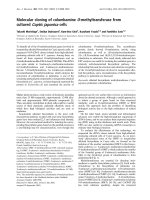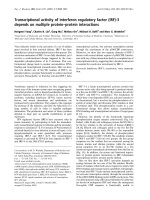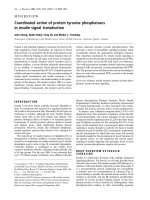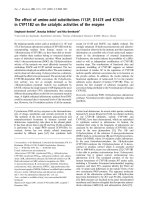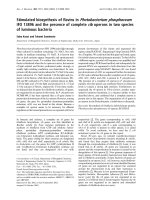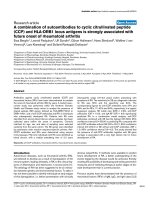Báo cáo Y học: Bromoperoxidase activity of vanadate-substituted acid phosphatases from Shigella flexneri and Salmonella enterica ser. typhimurium doc
Bạn đang xem bản rút gọn của tài liệu. Xem và tải ngay bản đầy đủ của tài liệu tại đây (245.85 KB, 6 trang )
Bromoperoxidase activity of vanadate-substituted acid phosphatases
from
Shigella flexneri
and
Salmonella enterica
ser.
typhimurium
Naoko Tanaka
1
, Vale
´
rie Dumay
1
, Qianning Liao
2
, Alex J. Lange
2
and Ron Wever
1
1
Institute for Molecular Chemistry, University of Amsterdam, The Netherlands;
2
Department of Biochemistry, Molecular Biology
and Biophysics, University of Minnesota Medical School and College of Biological Sciences, Minneapolis, Minnesota, USA
Vanadium haloperoxidases and the bacterial class A non-
specific acid phosphatases have a conserved active site. It is
shown that vanadate-substituted recombinant acid phos-
phatase from Shigella flexneri (PhoN-Sf) and Salmonella
enterica ser. typhimurium (PhoN-Se) in the presence of H
2
O
2
are able to oxidize bromide to hypobromous acid. Vanadate
is essential for this activity. The kinetic parameters for the
artificial bromoperoxidases have been determined. The K
m
value for H
2
O
2
is about the same as that for the vanadium
bromoperoxidases from the seaweed Ascophyllum nodosum.
However, the K
m
value for Br
–
is about 10–20 times higher,
and the turnover values of about 3.4 min
)1
and 33 min
)1
for
PhoN-Sf and PhoN-Se, respectively, are much slower, than
those of the native bromoperoxidase. Thus, despite the
striking similarity in the active-site structures of the vana-
dium haloperoxidases and the acid phophatase, the turnover
frequency is low, and clearly the active site of acid phos-
phatases is not optimized for haloperoxidase activity. Like
the native vanadium bromoperoxidase, the vanadate-sub-
stituted PhoN-Sf and PhoN-Se catalyse the enantioselective
sulfoxidation of thioanisole.
Keywords: acid phosphatase; brominating activity; enantio-
selective sulfoxidation; vanadium bromoperoxidase; vana-
dium chloroperoxidase.
Vanadium haloperoxidases are enzymes that catalyse the
oxidation of a halide by hydrogen peroxide to the corres-
ponding hypohalous acids according to:
H
2
O
2
þ H
þ
þ X
À
! H
2
O þ HOX
The enzymes are named after the most electronegative
halide ion they are able to oxidize, therefore chloroperoxi-
dase oxidizes Cl
–
,Br
–
,I
–
and bromoperoxidase oxidizes Br
–
and I
–
. This class of enzymes binds vanadate (HVO
4
2–
)asa
prosthetic group [1,2]. It is possible to prepare an apo form
of these enzymes which is re-activated by vanadate. This
re-activation is competitively inhibited by structural ana-
logues of vanadate (tetrahedral compounds) such as phos-
phate and molybdate [3,4]. The crystal structures [5–7] of
vanadium chloroperoxidase and bromoperoxidase from
fungus Curvularia inaequalis and the seaweed Ascophyllum
nodosum show that vanadate in these enzymes is covalently
attached to a histidine residue while five residues donate
hydrogen bonds to the nonprotein oxygens. The resulting
structure shown for the chloroperoxidase (Fig. 1A) is that
of a trigonal bipyramid with three nonprotein oxygens in
the equatorial plane which are hydrogen-bonded to Arg360,
Arg490, Lys353, Ser402, and Gly403. The fourth oxygen
(hydroxide group) at the apical position is hydrogen-bonded
to His404. The nitrogen atom from a histidine residue
(His496) is at the other apical position. The above vanadate-
binding amino acids were shown to be conserved in two
bromoperoxidases from seaweed and several acid phospha-
tases among the large group of soluble bacterial nonspecific
class A acid phosphatases [5,7–12]. Examples are the
nonspecific acid phosphatase from Shigella flexneri
(PhoN-Sf) and the enzyme from Salmonella enterica ser.
typhimurium (PhoN-Se) [13,14]. On the basis of sequence
similarity, it has been proposed [8–12] that the architecture
of the active site in the two classes of enzymes is very similar.
Recently the X-ray structure of a novel acid phosphatase
from Escherichia blattae was determined [15]. Figure 1B
shows the active-site structure of this acid phosphatase. The
similarity of the residues involved in binding oxyanions is
remarkable. Sulfate cocrystallises with the acid phosphatase,
and its binding site (Fig. 1B) is comparable to that of
vanadate in the chloroperoxidase (Fig. 1A), confirming that
these families are indeed evolutionary related and share the
same ancestor [8]. Hemrika et al. [8] showed that apo-
chloroperoxidase has some phosphatase activity, although
the turnover with p-nitrophenyl phosphate as a substrate is
only 1.7 min
)1
, which is about 10 000 times slower than
that of various acid phosphatases. However, the K
m
for the
substrate is less than 50 l
M
[8,16], which is of the same order
of magnitude as various acid phosphatases. These data
show that the active site of chloroperoxidase has a good
affinity for the substrate but is not optimized for phospha-
tase activity. On the basis of the similarity of the active sites
and the fact that the phosphatase activity of phosphatases is
inhibited by vanadate [17,18], we expect that vanadate-
substituted phosphatase has haloperoxidase activity. Indeed,
Correspondence to R. Wever, Institute for Molecular Chemistry,
University of Amsterdam, Nieuwe Achtergracht 129, 1018 WS
Amsterdam, the Netherlands.
Fax: + 31 20 5255670, Tel.: + 31 20 5255110,
E-mail:
Abbreviations: PhoN-Sf, acid phosphatase from Shigella flexneri;
PhoN-Se, acid phosphatase from Salmonella enterica ser.
typhimurium; MCD, monochlorodimedon; e.e., enantiomeric excess.
Enzymes: chloroperoxidase (EC 1.11.1.7), identification code IVNC;
bromoperoxidase, identification code 1Q19.
(Received 14 September 2001, revised 31 January 2002,
accepted 7 March 2002)
Eur. J. Biochem. 269, 2162–2167 (2002) Ó FEBS 2002 doi:10.1046/j.1432-1033.2002.02871.x
as shown here, recombinant PhoN-Sf and PhoN-Se
substituted with vanadate also catalyzed the oxidation of
bromide and the enantioselective oxidation of thioanisole
[19,20].
MATERIALS AND METHODS
Materials
All standard recombinant DNA procedures were performed
as described by Sambrook et al. [21].
The host strains Escherichia coli TOP10 (Invitrogen) and
BL21(DE3) (Novagen) were used in subcloning and
expression experiments. S. enterica ser. typhimurium strain
SB3507 was used as a DNA source for phoN-Se gene
cloning. Bacteria were routinely grown at 37 °CinLuria–
Bertani medium containing 100 lgÆmL
)1
ampicillin when
required (LA medium). Plasmid pKU102 harbouring the
Sh. flexneri phoN locus was a gift from Dr K. Uchiya [13].
Expression vectors pET3a (Novagen) and pBAD/gIIIA
(Invitrogen) were used to clone the phoN gene from
Sh. flexneri and S. typhimurium, respectively. pBAD/gIIIA
holds the gene III signal sequence for secretion of the
recombinant protein into the periplasmic space.
Expression and purification of recombinant PhoN-Se
S. enterica ser. typhimurium phoN gene was cloned in the
pBAD/gIIIA expression plasmid as follows. The mature
sequence (i.e. phoN gene without the 5¢ end coding for the
secretion signal) was PCR amplified from S. enterica
chromosomal DNA using the forward primer 5¢-A
CCA
TGGAATATACATCAGCAGAA-3¢ and the reverse pri-
mer 5¢-CGC
AAGCTTTCACCTTTCAGTAATT-3¢ (the
NcoIandHindIII sites, respectively, are underlined). The
PCR was performed using the Expand
TM
High fidelity PCR
System (Roche) with the following conditions: 1 lg chro-
mosomal DNA, 1 l
M
each primer, 200 l
M
each dNTP,
1.5 m
M
MgCl
2
, 2.6 U high-fidelity polymerase mix in a final
volume of 100 lL. A Ôhot startÕ of 2 min at 94 °Cwas
followed by 30 cycles of denaturation (15 s at 94 °C),
annealing (30 s at 55 °C) and extension (1 min at 72 °C)
using a programmable heating block (Eppendorf Master-
cycler 5330). The PCR product was restricted with NcoIand
HindIII and cloned into the corresponding sites of pBAD/
gIIIA, in-frame with the gene III signal sequence. The
resulting clone was confirmed by DNA sequencing using an
Applied Biosystems 373A DNA Sequencer.
Escherichia coli TOP10 carrying the recombinant plas-
mid was grown at 37 °C in LA medium until the
absorbance of the culture suspension reached an A
600
of
0.4–0.6. The expression of recombinant PhoN-Se was
induced by adding 0.02%
L
-arabinose and the growth was
continued at 37 °C for 4 h. The bacterial cells were
harvested by centrifugation, and secreted PhoN-Se was
released from E. coli periplasmic space by osmotic shock.
The cell pellet was resuspended in osmotic shock solution 1
(20 m
M
Tris/HCl, pH 8, 2.5 m
M
EDTA, 20% sucrose) to
A
600
¼ 5, and incubated on ice for 10 min. After centrif-
ugation for 1 min at 4 °C, the cell pellet was resuspended in
osmotic shock solution 2 (20 m
M
Tris/HCl,pH8,2.5m
M
EDTA) to A
600
¼ 5 and incubated on ice for 10 min. The
secreted PhoN-Se was obtained in the supernatant (osmotic
shock fluid) after centrifuging for 10 min at 4 °C. The
osmotic shock fluid was dialysed overnight at 4 °C against
20 m
M
sodium acetate buffer (pH 6.0). The solution was
passed through a 0.45-l
M
filter (Millipore) and then
applied to an SP Sepharose Fast Flow ion-exchange
column (Pharmacia Biotech). The recombinant protein
was eluted with a linear gradient of NaCl (0–0.3
M
)in
20 m
M
sodium acetate buffer (pH 6.0).
Expression and purification of recombinant PhoN-Sf
Sh. flexneri phoN was cloned under control of the T7
promoter in pET3a as described below. It was generated
by PCR using pKU102 as a template and suitable primers
that allowed cloning of phoN between NdeIandHindIII
sites of pET3a. The construct was transformed into the
T7 polymerase-expressing strain BL21(DE3). PhoN-Sf
Fig. 1. Structure of the active site of (A) vanadium chloroperoxidase from C. inaequalis (PDB ID: 1 IDQ) and (B) the acid phosphatase from E. blattae
(PDB ID:1D2T). The phosphatase cocrystallized with sulfate. The figure was prepared using
SWISS PDB
viewer.
Ó FEBS 2002 Haloperoxidase activity of phosphatases (Eur. J. Biochem. 269) 2163
expression was induced with 0.4 m
M
isopropyl isothio-b-
D
-
galactoside for 5–7 h at 37 °C.
Soluble PhoN-Sf was released from E. coli by breaking
the cells in a French press (5.17–5.24 MPa). The soluble
fraction was applied to a BioCAD ion-exchange column
(Perseptive Biosystems), and the enzyme was eluted with a
gradient of NaCl (0–1
M
)in30m
M
Tris/HCl buffer
(pH 7.5). The active fractions were pooled and applied to
a Sephacryl 200HR column (Pharmacia). Elution was with
30 m
M
Tris/HCl buffer (pH 7.5) containing 30 m
M
NaCl
and 10% glycerol.
The purity of the preparations was checked on SDS/
PAGE gels stained with Coomassie Brilliant Blue R-250. To
remove possible contaminating metal ions, the purified
phosphatases were eventually dialysed against 100 m
M
Tris/
HCl (pH 7.5) and 1 m
M
EDTA which has no effect on the
phosphatase activity.
The protein concentration was determined by using a
protein assay kit (Bio-Rad) with BSA as the standard.
Enzymatic assay of phosphatase activity
The phosphatase activity was measured by hydrolysis of
10 m
M
p-nitrophenyl phosphate as a substrate in 100 m
M
Mes (pH 6.0). The reaction mixtures were quenched with
0.5
M
NaOH to change the pH to 12 and the production of
p-nitrophenol was measured at 410 nm (absorption coeffi-
cient 16.6 m
M
)1
Æcm
)1
).
Enzymatic assay of bromoperoxidase activity
Assay of PhoN-Sf brominating activity. The brominating
activity of the recombinant phosphatases was measured
qualitatively by the bromination of 40 l
M
phenol red in
100 m
M
citrate buffer (pH 5.0) containing 2 m
M
H
2
O
2
and
100 m
M
Br
–
. This assay is convenient because large colour
changes are observed which can easily be detected visually
[22]. As phosphate ions inhibit the brominating activity of
PhoN-Sf, it is likely that phosphate binds at the active site of
the enzyme and prevents binding of the vanadate. Therefore
phosphate should be absent in the assay. To induce the
brominating activity of PhoN-Sf, the recombinant PhoN-Sf
was preincubated with 100 l
M
vanadate in 100 m
M
Tris/
HCl (pH 7.5) for at least 30 min. The brominating activity
of recombinant PhoN-Sf (final concentration 0.5 l
M
)was
quantitatively measured by monitoring the bromination of
50 l
M
monochlorodimedon (MCD) at 290 nm (absorption
coefficient 20.2 m
M
)1
Æcm
)1
) in 100 m
M
sodium acetate
buffer (pH 4.6) containing 200 m
M
Br
–
and 2 m
M
H
2
O
2
on a Cary 50 [23]. The kinetic parameters were determined
using the
ENZYMEKINETICS
program from Trinity Software.
Assay of PhoN-Se brominating activity. The brominating
activity of PhoN-Se was measured by the phenol red assay
as mentioned above but using sodium acetate (pH 4.6)
instead of citrate. It is well known [24] that vanadate
interacts with most buffers normally used. Therefore the
vanadate-induced brominating activity of PhoN was meas-
ured in two different buffers. As PhoN-Se brominating
activity was absent in citrate buffer and as it is likely that
citrate forms a complex, with vanadate inhibiting its
incorporation in the active site of PhoN, sodium acetate
was used as a buffer. Brominating activity of PhoN-Se was
quantitatively measured by monitoring the bromination of
50 l
M
MCD at 290 nm in 100 m
M
sodium acetate buffer
(pH 4.2) containing 300 m
M
Br
–
and 2 m
M
H
2
O
2
.The
assay mixture also contained 100 l
M
vanadate.
Enantioselective sulfoxidation of organic sulfide
The enantioselective sulfoxidation by the recombinant
phosphatases was demonstrated using thioanisole as a
substrate [20]. Thioanisole at a concentration of 2 m
M
was
incubated with 2 m
M
H
2
O
2
, 100 l
M
vanadate and 100 n
M
enzyme in 100 m
M
acetate buffer (pH 5.0) at 25 °Cin
1.7-mL sealed glass vials to prevent evaporation of the
substrate. After overnight incubation, H
2
O
2
remaining in
the reaction mixture was quenched with Na
2
SO
3
.The
enantiomeric products were extracted with dichloroethyl-
ene, evaporated to 20 lL, and dissolved in 1 mL hexane/
propan-2-ol (4 : 1, v/v). A 20-lL sample was used for
HPLC analysis on a Diacel chiral OD column
(0.46 · 25 cm) equipped with a Pharmacia LKB-HPLC
pump 2248 and an LKB Bromma 2140 rapid spectral
detector. The column was eluted with hexane/propan-2-ol
(4 : 1, v/v) at a flow rate of 0.5 mLÆmin
)1
.Theretention
times for the R and S isomer were 14 and 17 min,
respectively. The HPLC effluent was monitored at
254 nm. The Borwin software program (JMBS develop-
ments) was used for HPLC data acquisition and evaluation.
RESULTS AND DISCUSSION
Expression of recombinant acid phosphatases in
E. coli
The similarity in the active-site structures of vanadium
haloperoxidases and class A bacterial acid phosphatases
was first suggested by sequence alignments [8–10]. Indeed,
the comparison of the crystal structures of E. blattae acid
phosphatase and C. inaequalis vanadium chloroperoxidase
(Fig. 1) confirms this structural similarity [15]. Unfortu-
nately, the structure of the acid phosphatase complexed to
vanadate is not available, only that of a sulfate and a
molybdate complex [15]. The similarity prompted us to
investigate whether class A bacterial acid phosphatases with
vanadate bound to the active site could also function as
vanadium haloperoxidases. S. enterica ser. typhimurium [25]
and Sh. flexneri acid phosphatases, which show, respect-
ively, 40% and 80% homologies with E. blattae acid
phosphatase, were chosen for this study. A sequence
alignment (not shown) of vanadium chloroperoxidase with
these enzymes points to conservation of three separate
domains. Domain 1 contains Lys353 and Arg360; domain
2, Ser402, Gly403, His404, and domain 3, Arg490 and
His496. This shows clearly that the binding pocket for
vanadate in the peroxidases is very similar to the phosphate-
binding site in phosphatases. However, the overall similarity
between vanadium chloroperoxidase and these phosphatases
is very low (see also [8]), and the domains are connected by
regions that are highly variable. Both phosphatases were
expressed as recombinant proteins in E. coli, as described in
Materials and methods. No acid phosphatase activity was
detected in E. coli host strains TOP10 or BL21(DE3). In the
absence of inducer, neither TOP10, which harbours the
expression vector for PhoN-Se, nor BL21(DE3), which
harbours the expression vector for PhoN-Sf, showed
2164 N. Tanaka et al.(Eur. J. Biochem. 269) Ó FEBS 2002
relevant levels of acid phosphatase activity. On induction,
the specific activity of acid phosphatase in both strains was
about 40 UÆmg
)1
.
During purification, the acid phosphatase activity always
cochromatographed with a protein of about 30 kDa, in
agreement with the molecular mass of each phosphatase.
The final preparations with a yield of 1–2 mg Pho-Sf per L
of culture medium were judged to be at least 90% pure by
SDS/PAGE. There is a minor band present with a slightly
lower molecular mass. However, this band originates from
proteolytic degradation of the native phosphatase according
to a mass analysis of its tryptic peptides by matrix-assisted
laser desorption ionization time-of-flight MS (not shown).
In the case of PhoN-Se, 10–15 mg enzyme, with a specific
activity of 140 UÆmg
)1
, was obtained from 1 L of culture,
indicating a high level of expression in E. coli.Moreover,
the purification procedure was greatly simplified by target-
ing the phosphatase to E. coli periplasmic space.
Haloperoxidase activity of vanadate-substituted acid
phosphatases
The brominating activity of recombinant PhoN-Sf and
PhoN-Se was tested in a phenol red assay. After overnight
incubation of 1 l
M
PhoN-Sf and PhoN-Se, respectively, in
the presence of 100 l
M
vanadate, phenol red was clearly
brominated to bromophenol blue by both phosphatases. In
the absence of vanadate or PhoN, bromination of the dye
was not detected. This means that the reaction is catalysed
by the vanadate-substituted PhoN-Sf and PhoN-Se. Bind-
ing of vanadate to the active site of PhoN-Sf is confirmed by
the observation that vanadate inhibits the phosphatase
activity of PhoN-Sf with a K
i
% 70 n
M
at pH 6.0 (results
not shown). Many other phosphatases are inhibited by
vanadate [17,18], which is homologous in structure to
phosphate. Although it has no sequence similarity to the
bacterial acid phosphatases, the crystal structure of the
vanadate-substituted rat acid phosphatase shows clearly
that vanadate binding was strikingly similar to that in the
vanadium chloroperoxidase from C. inaequalis [10]. There-
fore, it is likely that vanadate binds to the active site of
PhoN and causes the peroxidase-like activity.
Further quantitative kinetic studies were carried out using
the MCD assay. Figure 2A shows that % 10 l
M
vanadate is
necessary to obtain full activity of 500 n
M
PhoN-Sf. From a
Hill plot (not shown) it was possible to obtain a K
d
of
% 1 l
M
at pH 4.6. In the presence of 100 l
M
vanadate, it
takes % 20 min to fully induce the brominating activity of
PhoN-Sf (result not shown). Therefore, at least 30 min of
preincubation with 100 l
M
vanadate was carried out with
PhoN-Sf as described in Materials and methods. Figure 2B
shows that % 20 l
M
vanadate is necessary to activate 1 l
M
PhoN-Se, and a K
d
of % 2 l
M
at pH 4.2 was obtained.
PhoN-Se reaches full peroxidase activity within 2 min when
100 l
M
vanadate is present (result not shown). In the case of
PhoN-Se, preincubation was not necessary, therefore
100 l
M
vanadate was added to the MCD assay mixture
for further experiments.
As described in Materials and methods, buffers contain-
ing citrate or phosphate are not suitable for measuring
brominating activity of PhoN, therefore sodium acetate was
used in the assay to determine the pH optimum. Figure 3
shows that the maximal brominating activity is observed at
pH 4.6 and pH 4.2 for PhoN-Sf and PhoN-Se, respectively.
Owing to the restricted choice of buffers, experiments were
carried out over a limited pH range. Sodium acetate was
used in the pH range 4.2–5.4 and pH 3.8–6.0 for PhoN-Sf
and PhoN-Se, respectively. This makes it difficult to
evaluate the pK
a
value of the group involved in the
bromination activity of these phosphatases. As only a
limited amount of enzyme was available, the determination
of the optimum pH of PhoN-Sf was based on a single
substrate concentration (200 m
M
KBr and 2 m
M
H
2
O
2
).
For PhoN-Se it was possible to measure K
m
and V at each
pH value. Figure 3B shows the pH-dependence of V.The
data suggest that a group with a pK
a
of % 4.3 is involved in
the bromination reaction. The K
m
forbromidewasalso
pH-dependent and increases with increasing pH (not shown).
A steady-state kinetic study of the brominating activity of
vanadate-substituted PhoN-Sf and PhoN-Se was carried
out. For PhoN-Sf, a K
m
of % 350 m
M
was obtained for
bromide (Fig. 4A), and for PhoN-Se a K
m
of % 160 m
M
(Fig. 4C). The maximal turnover for the brominating
activity of vanadate-substituted PhoN-Sf is 3.4 min
)1
(0.13 UÆmg
)1
), which is considerably slower than the values
Fig. 2. Dependence of the bromoperoxidase activity of (A) PhoN-Sf
(200 n
M
)and(B)PhoN-Se(1l
M
) on the vanadate concentration. (A)
20 l
M
PhoN-Sf was preincubated for 1 h with various concentrations
of vanadate, and the activity was measured by the MCD assay
(pH 4.6). (B) PhoN-Se was preincubated for 1 h with various con-
centrations of vanadate, and the activity was measured by the MCD
assay (pH 4.2).
Fig. 3. pH-dependence of the brominating activity of (A) 200 n
M
PhoN-
Sf and (B) 1 l
M
PhoN-Se. (A) 20 l
M
PhoN-Sf was preincubated for
1.5 h with 100 l
M
vanadate in 100 m
M
Tris/HCl (pH 7.5), and the
activity was measured by the MCD assay. (B) PhoN-Se was preincu-
bated for 1.5 h with various concentrations of vanadate, and the
activity was measured by MCD assay. K
m
and V for KBr at each pH
were recorded. The activity measurements were carried out in tripli-
cate.
Ó FEBS 2002 Haloperoxidase activity of phosphatases (Eur. J. Biochem. 269) 2165
of 120–180 UÆmg
)1
observed for vanadium haloperoxidases
[26,27]. However, the turnover for the brominating activity
of the acid phosphatases is of the same order of magnitude
as the phosphatase activity of apo-chloroperoxidase
(1.7 min
)1
)[8].TheK
m
for H
2
O
2
was also determined,
and a value of 15 l
M
was obtained with a maximal turnover
of 2.7 min
)1
(Fig. 4B). Surprisingly, the maximal turnover
for the brominating activity of vanadate-substituted
PhoN-Se was 33 min
)1
(1.23 UÆmg
)1
), which was about
10-fold higher than that for PhoN-Sf and the phosphatase
activity of apo-chloroperoxidase. Although PhoN-Se has
higher brominating activity than PhoN-Sf, the K
m
for H
2
O
2
was % 400 l
M
(Fig. 4D). The specificity constants (k
cat
/K
m
),
which can be calculated from these data, are 0.16
M
)1
Æs
)1
and 2
M
)1
Æs
)1
for bromide oxidation by PhoN-Sf and
PhoN-Se, respectively. If one compares these values with the
specificity constant for bromide oxidation [28] by the
bromoperoxidase from A. nodosum (1.8 · 10
5
M
)1
Æs
)1
), it
is clear that the vanadate-substituted acid phosphatases are
poor catalysts in bromide oxidation.
As several vanadium haloperoxidases are able to catalyse
the enantioselective sulfoxidation of thioanisole [19,20], we
investigated whether the PhoN-Sf and PhoN-Se catalysed
this reaction. Indeed, when 0.5 l
M
PhoN-Sf was incubated
overnight with 2 m
M
thioanisole and 2 m
M
H
2
O
2
in
100 m
M
acetate (pH 5.0) in the presence of 100 l
M
vanadate, the thioanisole was partially converted into the
R enantiomer of the sulfoxide, with an enantiomeric excess
(e.e.) of 57% (results not shown). Owing to the limited
amount of enzyme available, further studies were carried
out at a relatively low enzyme concentration of 0.1 l
M
.At
the lower concentration of PhoN-Sf (0.1 l
M
), the e.e.
decreased to 39%. This has been noted before and is due to
an increased contribution of the direct reaction between the
sulfide and H
2
O
2
leading to a racemic mixture [20]. Some
conversion into the sulfoxide was noted in the absence of
vanadate, but a racemic mixture resulted (not shown). Also
when vanadate was incubated with thioanisole and H
2
O
2
,a
minor amount of a racemic mixture resulted. It is clear that
vanadate is essential for the enantioselective sulfoxidation
activity of PhoN-Sf. PhoN-Se also catalyzes the sulfoxida-
tion of thioanisole, but in this case the S enantiomer was
produced with a selectivity of 36%. Surprisingly, in the
absence of vanadate an enantioselective conversion was also
observed (e.e. 24%). However, the conversion was much
slower than when vanadate was present. As further
incubation of PhoN-Sf, the sulfide and H
2
O
2
with 1 m
M
EDTA resulted in a lower e.e., the sulfoxidation observed in
the absence of vanadate may be due to metal contamination
in the preparation that was not completely removed by
dialysis against 1 m
M
EDTA. Recently, it has been reported
that vanadate-incorporated phytase [29], an unrelated
phosphatase that mediates the hydrolysis of phosphate
esters, also catalyses the enantioselective sulfoxidation of
prochiral sulfides with H
2
O
2
to the S-sulfoxides. However,
brominating activity, was not detected.
The kinetic data obtained previously [8,16] showed that,
despite the similarity in the structure of the active sites of the
vanadium haloperoxidases and the acid phosphatases (see
Fig. 1), apo-chloroperoxidase is not optimized for the
phosphatase activity, and vice versa the vanadate-substi-
tuted phosphatases show only moderate peroxidase activity.
This means that other residues further away from the active
site and probably near, or at the entrance to, the active site
play a very important role in tuning the activity and
specificity of these enzymes. Identification of these residues
even with a full knowledge of the crystal structure and
sequence is difficult, if possible at all. Studies of which
factors determine whether a vanadium haloperoxidase is a
bromoperoxidase or a chloroperoxidase [7,16] have also
been equivocal. Despite the fact that structural data and
kinetic details are available for these enzymes, and even site-
directed mutagenesis studies have been carried out [29], the
nature of these factors is not clear.
Our findings have important implications. There have
been many attempts to construct enzyme mimics or create
synthetic enzymes using knowledge of the active-site struc-
ture of enzymes. In general, these mimics are comparatively
poor catalysts. Our study clearly shows that despite the
similarity in active-site structure, the activities of these
enzymes differ widely. As pointed out above, these differ-
ences are probably due to amino-acid residues outside the
active site, which appear to be very important in catalysis
and determining specificity. This suggests that construction
of an artificial enzyme with similar activity to the original on
the basis of its active site is going to be more difficult than
expected.
ACKNOWLEDGEMENTS
This work was supported by the Council of Chemical Sciences of the
Netherlands organization for Scientific Research, the E.U. Research
Training Network on Peroxidases in Agriculture, the Environment and
Fig. 4. Bromoperoxidase activity of vanadate-substituted PhoN-Sf
(0.2 l
M
) at pH 4.6 and PhoN-Se (1 l
M
)atpH4.2asafunctionofthe
substrate concentration. PhoN-Sf was preincubated for 1 h in 100 m
M
Tris/HCl (pH 7.5) with 100 l
M
vanadate and the activity measured in
the MCD assay. (A) PhoN-Sf in 2 m
M
H
2
O
2
and variable concen-
trations of Br
–
.(B)PhoN-Sfin300m
M
Br
–
and variable concentra-
tions of H
2
O
2
. (C) PhoN-Se in 2 m
M
H
2
O
2
and variable
concentrations of Br
–
.(D)PhoN-Sein300m
M
Br
–
and variable
concentrations of H
2
O
2
. The data points are means of triplicate
measurements.
2166 N. Tanaka et al.(Eur. J. Biochem. 269) Ó FEBS 2002
Industry (ERBFMRXCT 980200) and the grant NIH-DK 38354. We
thank Dr K. Uchiya for providing the E. coli strain XL-1 lacking the
phoN-sf locus.
REFERENCES
1. DeBoer,E.,vanKooyk,Y.,Tromp,M.G.M.,Plat,H.&Wever,
R. (1986) Bromoperoxidase from Ascophyllum nodosum:anovel
class of enzymes containing vanadium as a prosthetic group?
Biochim. Biophys. Acta 869, 48–53.
2. Van Schijndel, J.W.P.M., Vollenbroek, E.G.M. & Wever, R.
(1993) The chloroperoxidse from the fungus Curvularia inaequalis:
a novel vanadium enzyme. Biochim. Biophys. Acta 1161, 249–256.
3. De Boer, E., Boon, K. & Wever, R. (1988) Electron paramagnetic
resonance studies on conformational states and metal ion
exchange properties of vanadium bromoperoxidase. Biochemistry
27, 1629–1635.
4. Tromp, M.G.M., ÔOlafsson, G., Krenn, B.E. & Wever, R. (1989)
Some structural aspects of vanadium bromoperoxidase from
Ascophyllum nodosum. Biochim. Biophys. Acta 1040, 192–198.
5. Messerschmidt, A. & Wever, R. (1996) First X-ray structure of a
vanadium-containing enzyme: chloroperoxidase from the fungus
Curvularia inaequalis. Proc. Natl Acad. Sci. USA 93, 392–396.
6. Messerschmidt, A., Prade, L. & Wever, R. (1997) Implications for
the catalytic mechanism of the vanadium-containing enzyme
chloroperoxidase from the fungus Curvularia inaequalis by X-ray
structures of the native and peroxide form. Biol. Chem. 378,
309–315.
7. Weyand, M., Hecht, H J., Kiess, M., Liaud, M F., Vilter, H. &
Schomburg, D. (1999) X-ray structure determination of a
vanadium-dependent haloperoxidase from Ascophyllum nodosum
at 2.0 A
˚
resolution. J. Mol. Biol. 293, 864–865.
8. Hemrika, W., Renirie, R., Dekker, H.L., Barnett, P. & Wever, R.
(1997) From phosphatases to vanadium peroxidases: a similar
architecture of the active site. Proc. Natl Acad. Sci. USA 94,
2145–2149.
9. Stukey, J. & Carman, G.M. (1997) Identification of a novel
phosphatase sequence motif. Protein Sci. 6, 469–472.
10. Neuwald, A.F. (1997) An unexpected relationship between
integral membrane phosphatases and soluble haloperoxidases.
Protein Sci. 6, 469–472.
11. Plass, W. (1999) Phosphate and vanadate in biological systems:
chemical relatives or more? Angew. Chem. 38, 909–912.
12. Zhang, Q X., Pilquil, C.S., Dewald, J., Berthiaume, L.B. &
Brindley, D.N. (2000) Identification of structurally important
domains of lipid phosphate phosphatases-1: implications for its
sites of action. Biochem. J. 345, 181–184.
13. Uchiya, K I., Tohsuji, M., Nikai, T., Sugihara, H. & Sasakawa,
C. (1996) Identification and characterization of phoN-Sf,ageneon
the large plasmid of Shigella flexneri 2a encoding a nonspecific
phosphatase. J. Bacteriol. 178, 4548–4554.
14. Rossolini, G.M., Schippa, S., Ricco, M.L., Berlutti, F., Macaskie,
L.E.&Thaller,M.C.(1998)Bacterialnonspecificacidphospho-
hydrolases: physiology, evolution and use as tools in microbial
biotechnology. Cell. Mol. Life Sci. 54, 833–850.
15. Ishikawa, K., Mihara, Y., Gondoh, K., Suzuki, E I. & Asano, Y.
(2000) X-ray structures of a novel acid phosphatase from
Escherichia blattea and its complex with the transition-state analog
molybdate. EMBO J. 19, 2412–2423.
16. Renirie, R., Hemrika, W. & Wever, R. (2000) Peroxidase and
phosphatase activity of actives site mutants of vanadium chlor-
operoxidase from the fungus Curvularia inaequalis: implications
for the catalytic mechanism. J. Biol. Chem. 275, 11650–11657.
17. Singh, J., Nordlie, R.C. & Jorgenson, R.A. (1981) Vanadate: a
potent inhibitor of multifunctional glucose-6-phosphatase. Bio-
chim. Biophys. Acta 678, 477–482.
18. Vescina, C.M., Salice, V.C., Cortizo, A.M. & Etcheverry, S.B.
(1996) Effects of vanadium compounds on acid phosphatase
activity. Biol. Trace Elem. Res. 53, 185–191.
19. Andersson, M., Willets, A. & Allenmark, S. (1997) Asymmetric
sulfoxidation catalyzed by a vanadium-containing bromoperox-
idase. J. Org. Chem. 62, 8455–8458.
20.TenBrink,H.B.,Tuynman,A.,Dekker,H.L.,Hemrika,W.,
Izumi, Y., Oshiro, T., Schoemaker, H.E. & Wever, R. (1998)
Enantioselective sulfoxidation catalyzed by vanadium haloper-
oxidases. Inorg. Chem. 37, 6780–6784.
21. Sambrook, J., Frischt, E.F. & Maniatis, T. (1989) Molecular
Cloning: a Laboratory Manual, 2nd edn. Cold Spring Harbor
Laboratory Press, Cold Spring Harbor, NY.
22. De Boer, E., Plat, H., Tromp, M.G.M., Wever, R., Franssen,
M.C.R., van der Plas, H.C., Meijer, E.M. & Schoemaker, H.E.
(1987) Vanadium containing bromoperoxidase: an example of an
oxidoreductase with high operational stability in aqueous and
organic media. Biotechnol. Bioeng. 30, 607–610.
23. Wever, R., Plat, H. & de Boer, E. (1985) Isolation procedure and
some properties of the bromoperoxidase from the seaweed Asco-
phyllum nodosum. Biochim. Biophys. Acta 830, 181–186.
24. Crans, D.C. & Tracey, A.S. (1998) The chemistry of vanadium in
aqueous and nonaqeous solution. In Vanadium Compounds.
Chemistry, Biochemistry, and Therapeutic Applications (Tracey,
A.S. & Crans, D.C., eds), pp. 2–29. American Chemistry Society,
Washington, DC.
25. Kasahara, M., Nakata, A. & Shinagawa, H. (1991) Molecular
analysis of the Salmonella typhimurium phoN gene which encodes
nonspecific acid-phosphatase. J. Bacteriol. 173, 6760–6765.
26. Hemrika, W., Renirie, R., Macedo-Ribeiro, S., Messerschmidt, A.
& Wever, R. (1999) Heterologous expression of the vanadium-
containing chloroperoxidase from Curvularia inaequalis and site-
directed mutagenesis of the active site residues His496, Lys353,
Arg360 and Arg490. J. Biol. Chem. 274, 23820–23827.
27. De Boer, E. & Wever, R. (1988) The reaction mechanism of the
novel vanadium bromoperoxidase: a steady-state kinetic analysis.
J. Biol. Chem. 263, 12326–12332.
28. Wever, R. & Hemrika, W. (2001) Vanadium haloperoxidases. In
Handbook of Metalloproteins (Messerschmidt, A., Huber, R.,
Poulos, T. & Wieghart. K., eds), pp. 1417–1428. John Wiley &
Sons, Chichester.
29. Van der Velde, F., Ko
¨
nemann, L., Van Rantwijk. F. & Sheldon,
R.A. (2000) The rational design of semisynthetic peroxidases.
Biotechnol. Bioeng. 67, 87–96.
Ó FEBS 2002 Haloperoxidase activity of phosphatases (Eur. J. Biochem. 269) 2167


